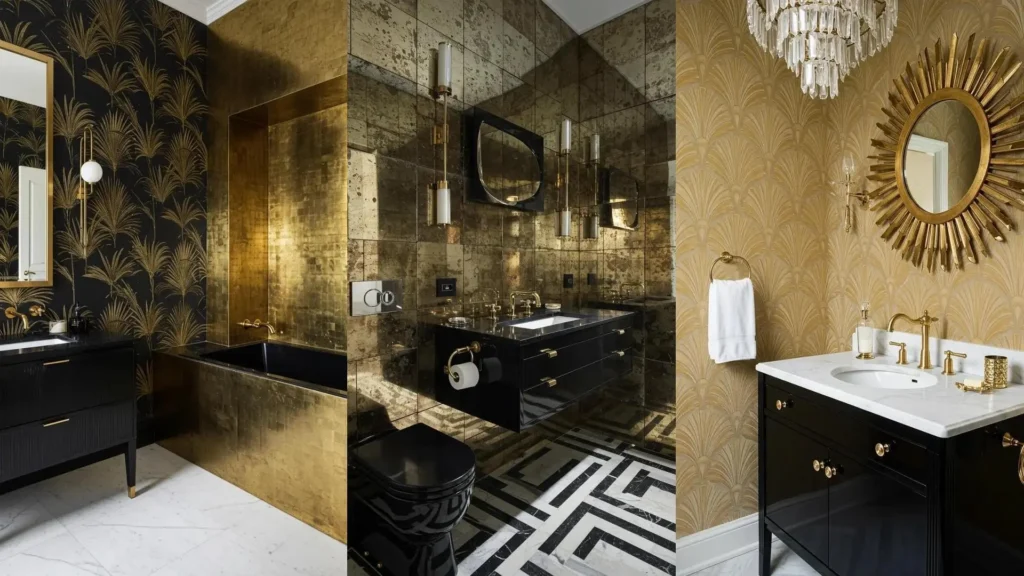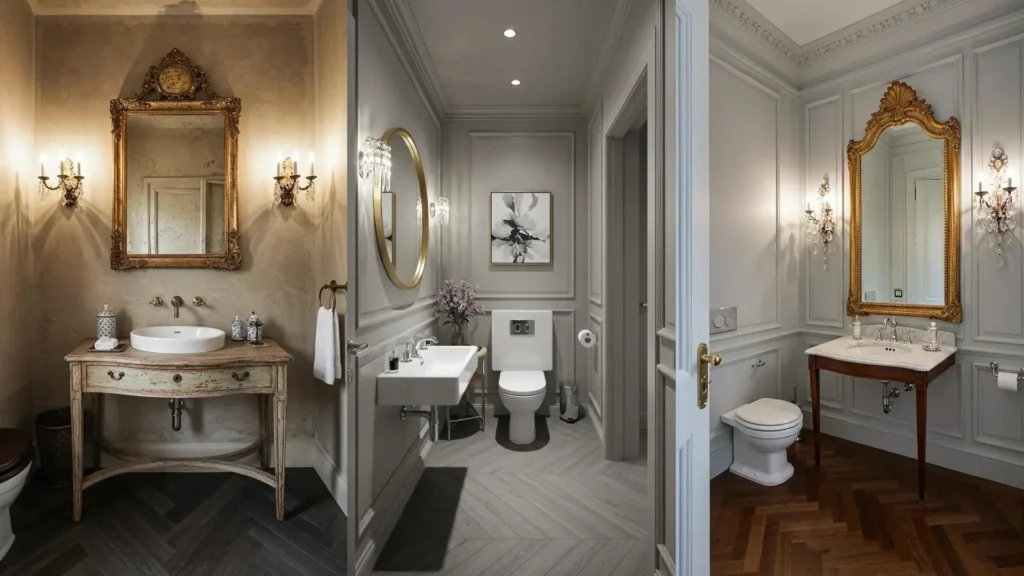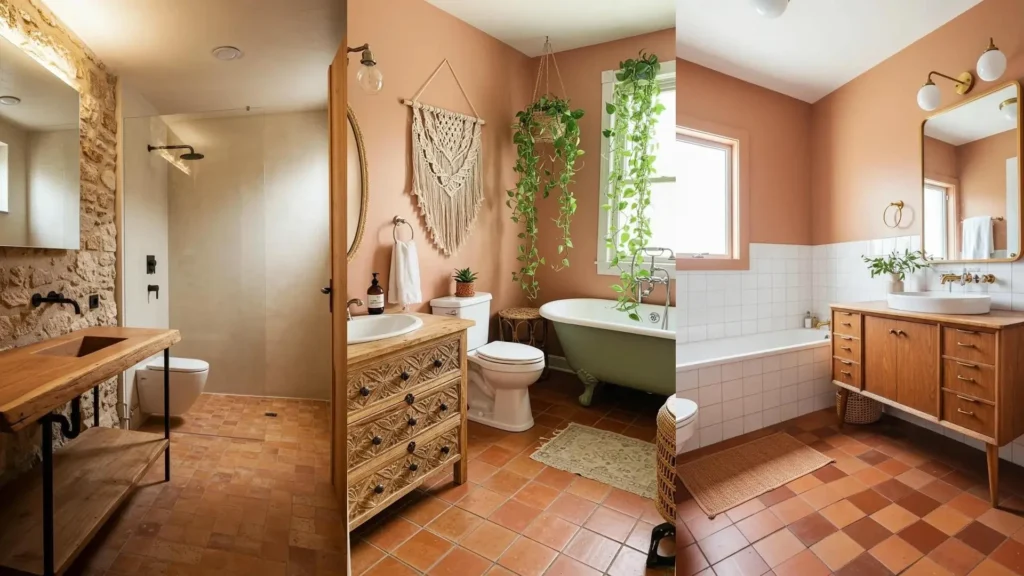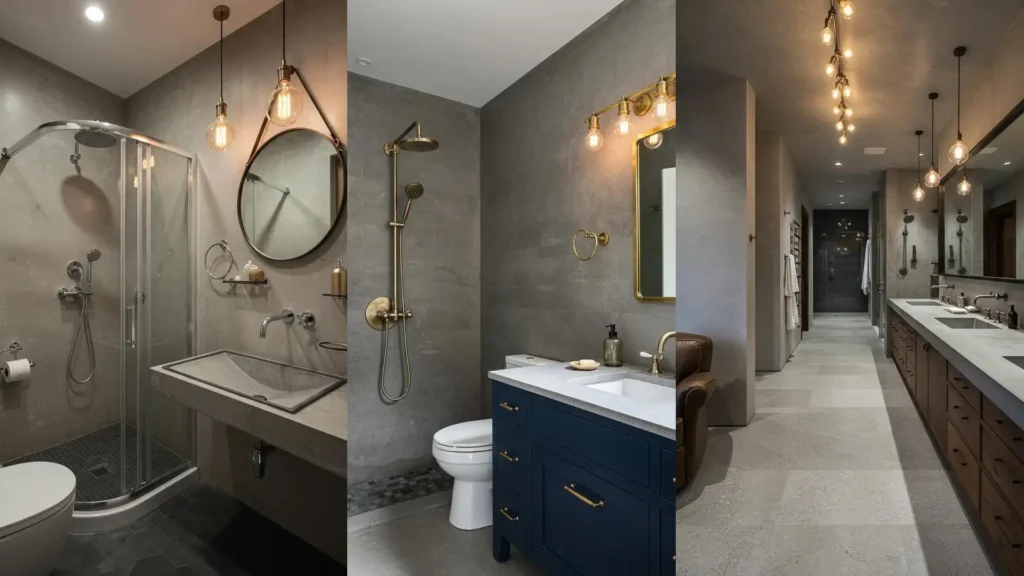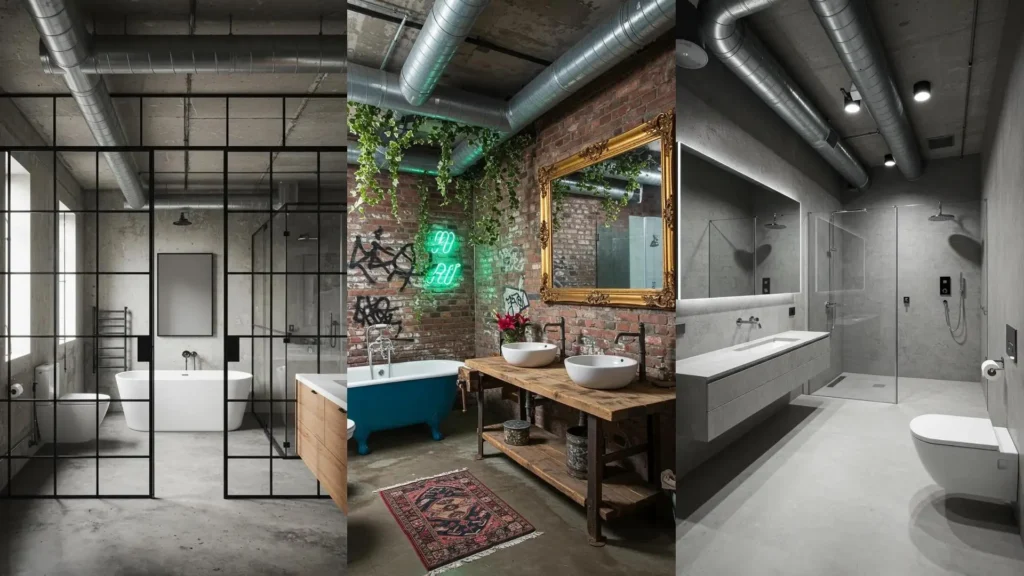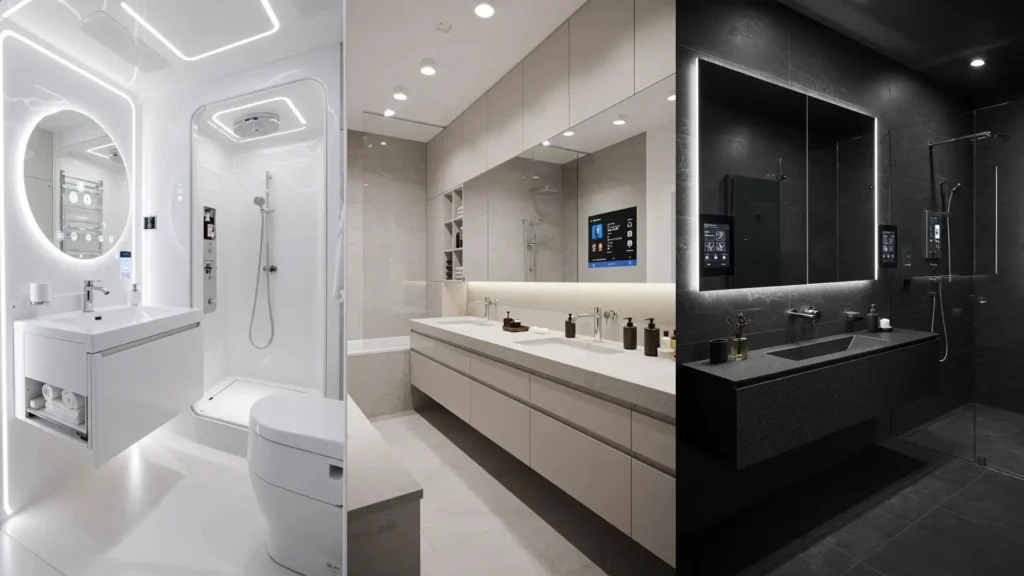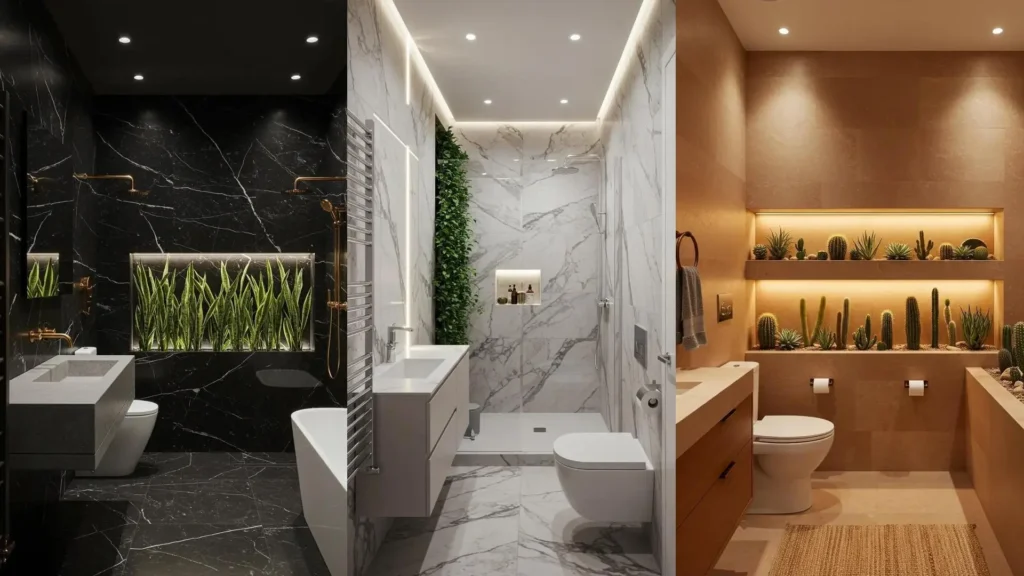There is an undeniable allure to Art Deco design—a sense of confidence, glamour, and permanence that feels incredibly appealing in a personal space like a bathroom.
It’s a style defined by bold contrasts, satisfying symmetry, and the beautiful tension between sleek lines and opulent details.
But capturing this spirit in your own home is not about creating a museum piece. It’s about choosing elements that resonate with you—the warmth of brass, the drama of a high-contrast floor, the elegance of a curved mirror—and weaving them into a space that feels like a sophisticated, personal retreat.
Here, you’ll find ways to bring that structured beauty into your bathroom, turning your daily routines into moments of quiet luxury.
1. Balance Bold Floors with Simplified Shapes
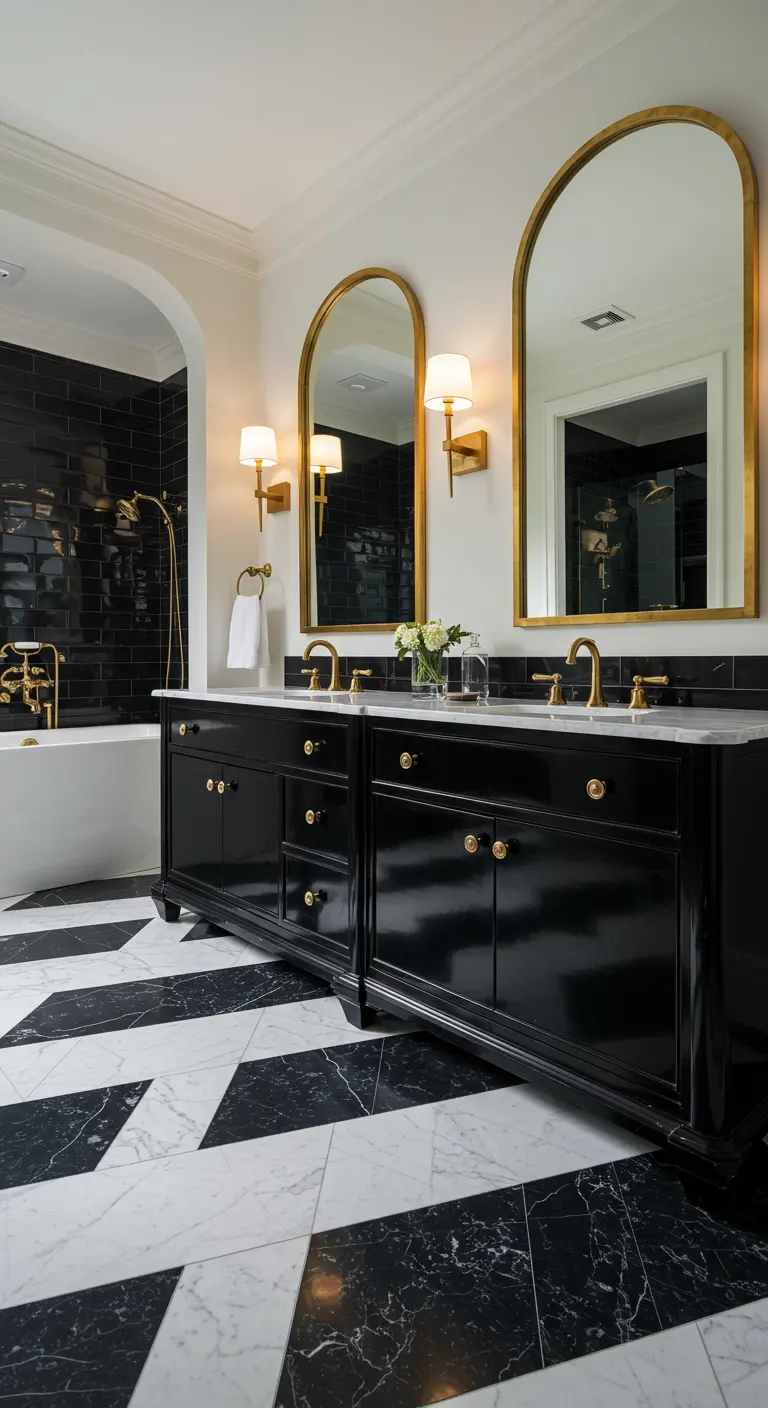
When using a high-impact, geometric floor, balance the look with softer shapes above.
Notice how the elegant, arched brass mirrors counteract the sharp angles of the tile, creating a sophisticated visual dialogue rather than competition.
You can achieve a similar effect by pairing a busy floor with a simple, round mirror or light fixtures with soft, curved lines.
To ground the space, a black lacquer vanity provides a solid, reflective block of color that connects to both the floor and the glossy shower tiles, proving that even in a bold room, cohesiveness is key.
2. Layer Light and Pattern for Maximum Glamour

Create a space that feels truly decadent by layering pattern with multiple light sources and reflective surfaces.
A metallic fan-patterned wallpaper provides the graphic foundation, while a sculptural sunburst mirror adds depth and another layer of the signature Deco motif.
Finally, a cascading crystal chandelier doesn’t just illuminate the room; it refracts light, scattering it across the metallic surfaces for a shimmering, multi-dimensional effect.
For a similar feel, try combining geometric plates and metallic highlights in your design choices, even in small accessories.
3. Use Vertical Tile to Elevate Ceiling Height
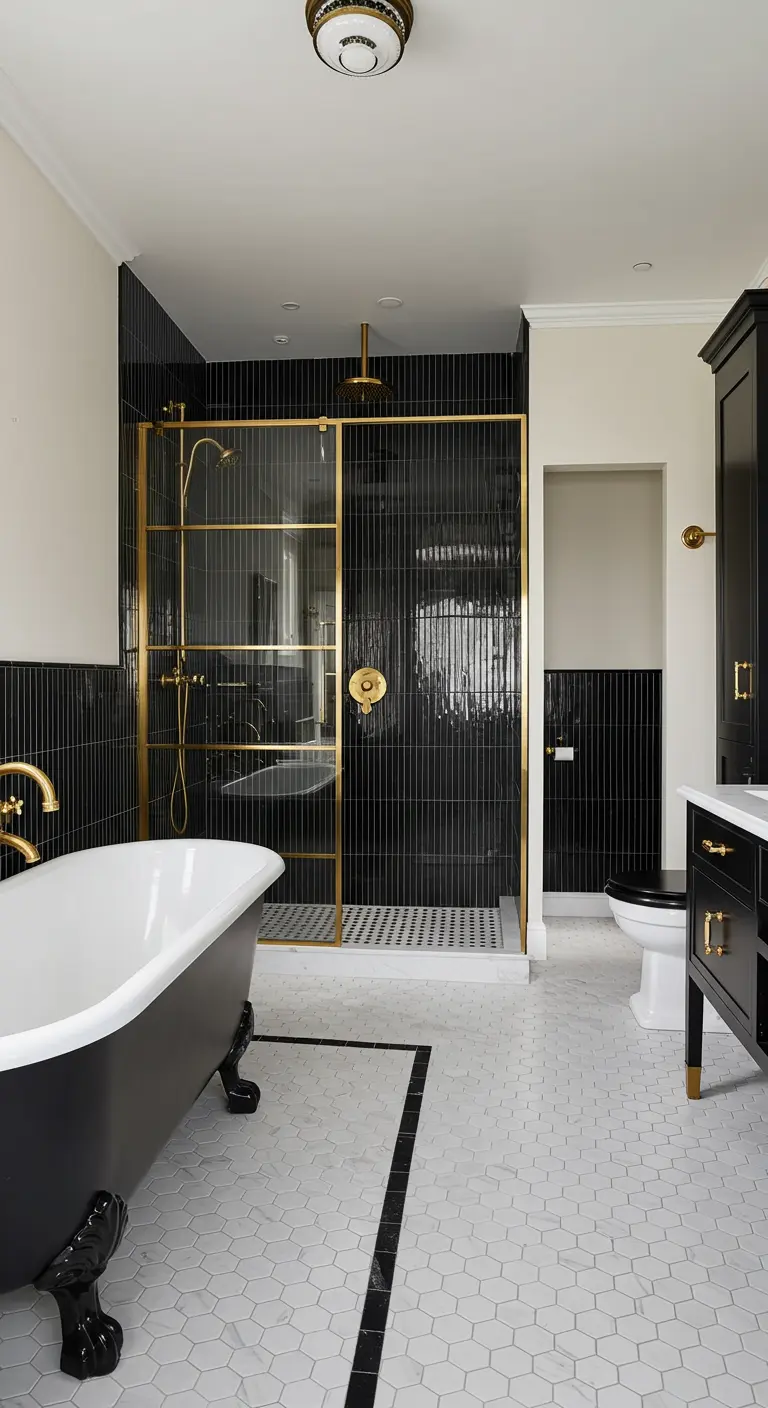
In any bathroom, you can create the illusion of a higher ceiling by choosing vertically-oriented tiles.
The glossy black tiles here draw the eye upward, making the shower enclosure feel taller and more grand.
This verticality is balanced by the classic, small-scale honeycomb tile on the floor, which grounds the space.
A simple black border on the floor frames the room, a subtle detail that adds a crisp, finished feel reminiscent of timeless black and white checkerboard bathrooms.
4. Embrace the Drama of a Dark Powder Room
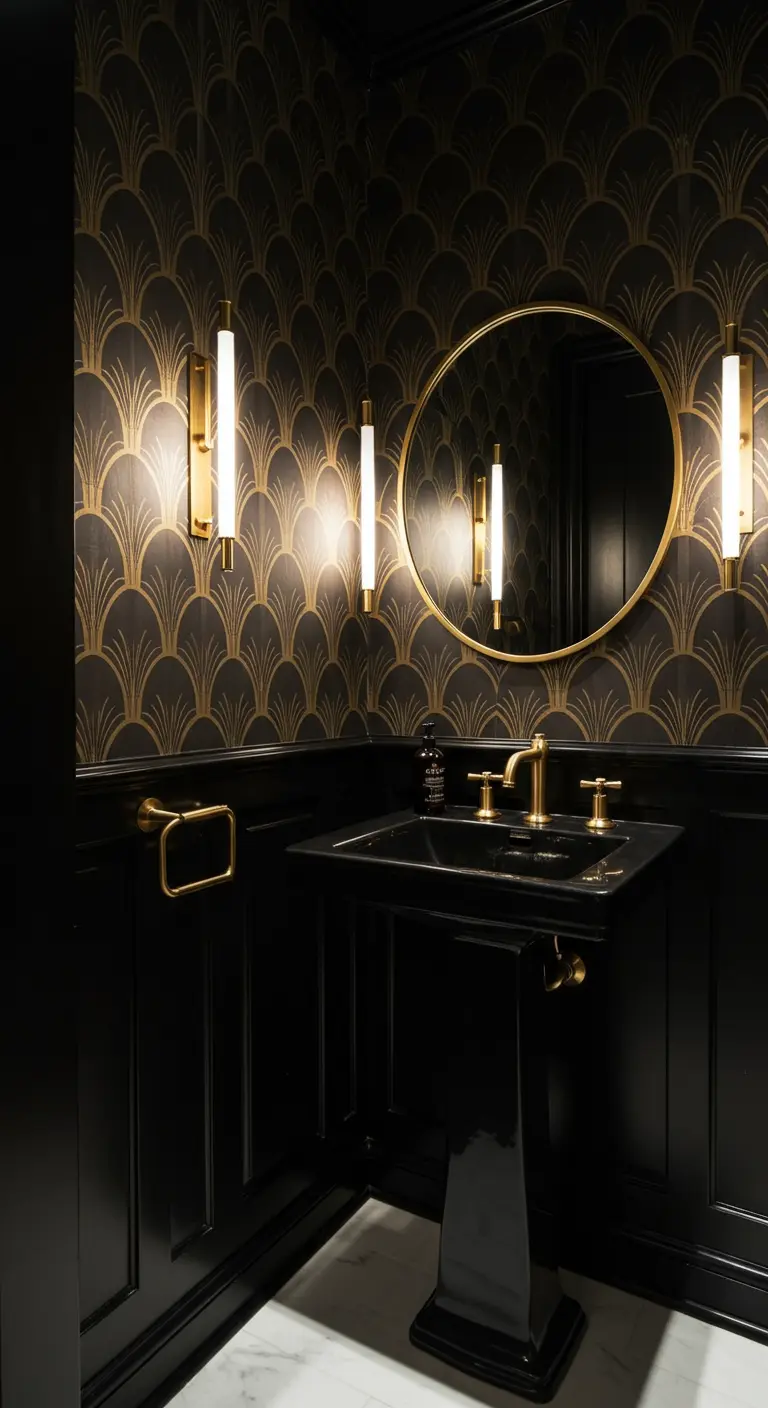
Do not be afraid to use dark, saturated colors in a small space like a powder room.
Instead of making it feel cramped, enveloping the room in black—from the paneled walls to the wallpaper and pedestal sink—creates an intimate, jewel-box effect.
The key is strategic lighting: slim, vertical sconces flank the mirror to cast an even, flattering glow, preventing shadows.
This approach transforms a utilitarian space into a dramatic statement, much like some dark glam bedroom spaces.
5. Introduce Jewel Tones for Unexpected Richness
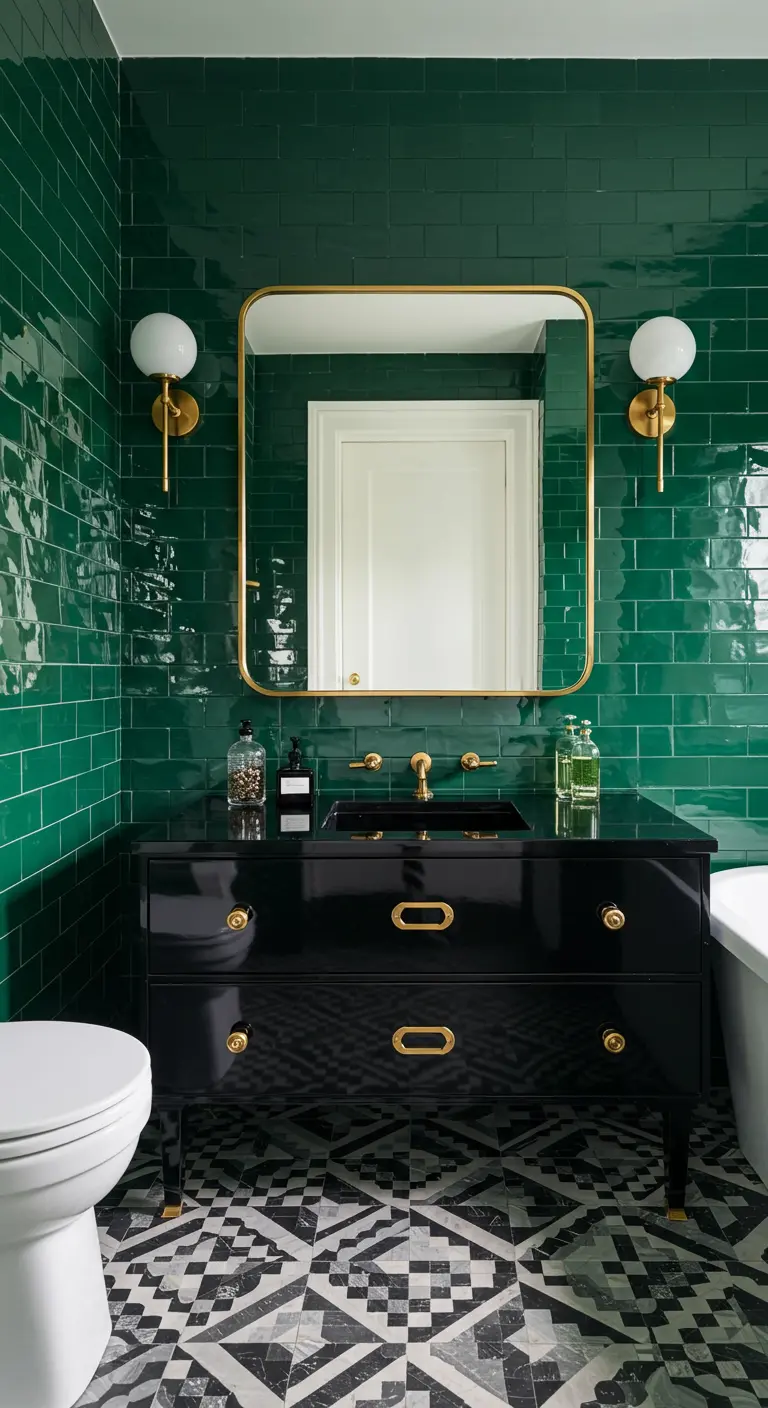
While black and gold are Art Deco staples, a rich jewel tone like emerald green can add a layer of unexpected personality and depth.
The high-gloss finish of the subway tiles reflects light beautifully, ensuring the deep color feels luxurious, not heavy.
Notice how simple, modern globe sconces provide a soft contrast to the sharp lines of the vanity and floor tile, proving that mixing shapes is essential for balance.
This use of bold color is seen in many eclectic colorful spaces.
6. Unify with a Bold, Continuous Pattern
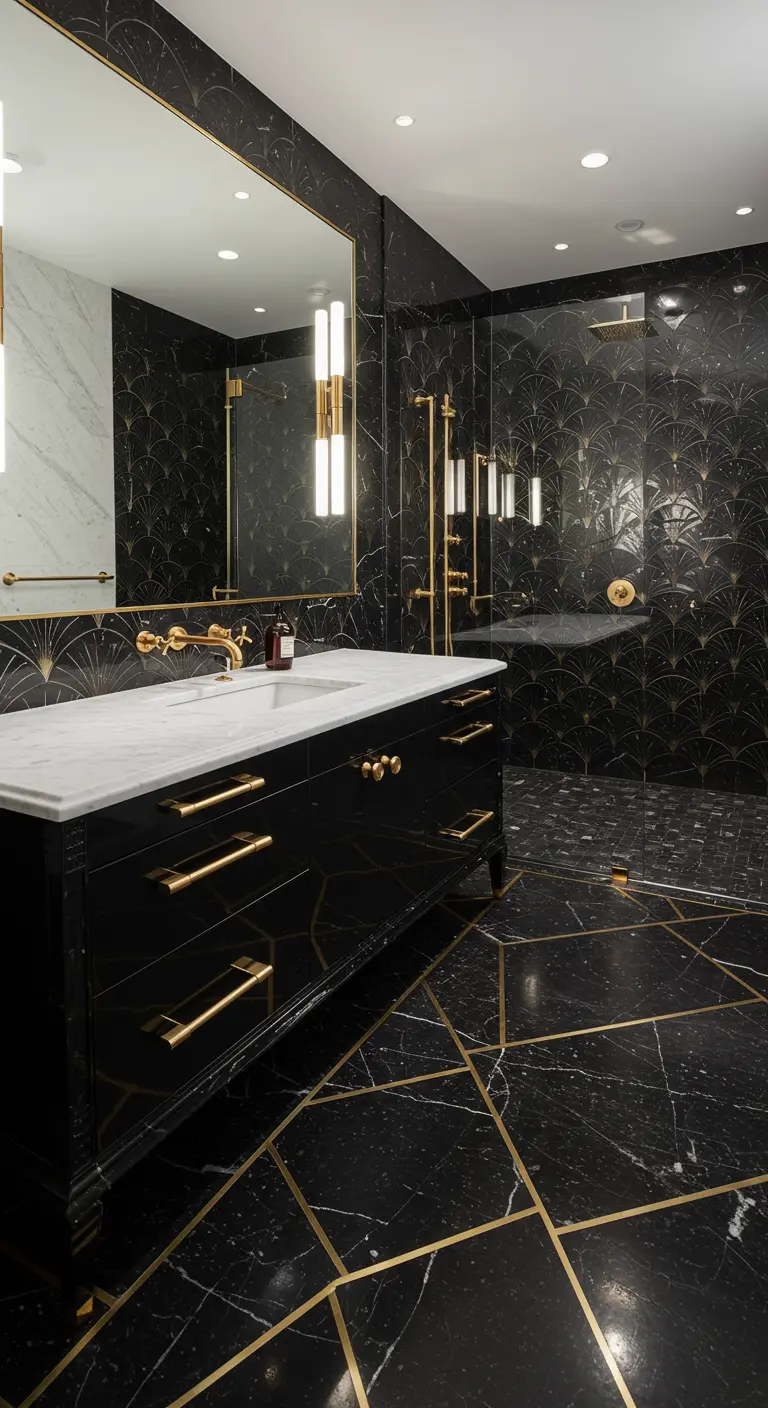
For a truly immersive and dramatic design, use the same bold tile on both the floor and walls.
Here, the black fan-shaped tile, a hallmark of the Deco era, creates a seamless, enveloping effect in the shower that extends onto the backsplash.
The floor’s black marble with brass inlays elevates the look further, adding a graphic element that feels both modern and classically opulent, a technique seen in elegant black & gold dining rooms.
7. Modernize Classic Tile with High Contrast
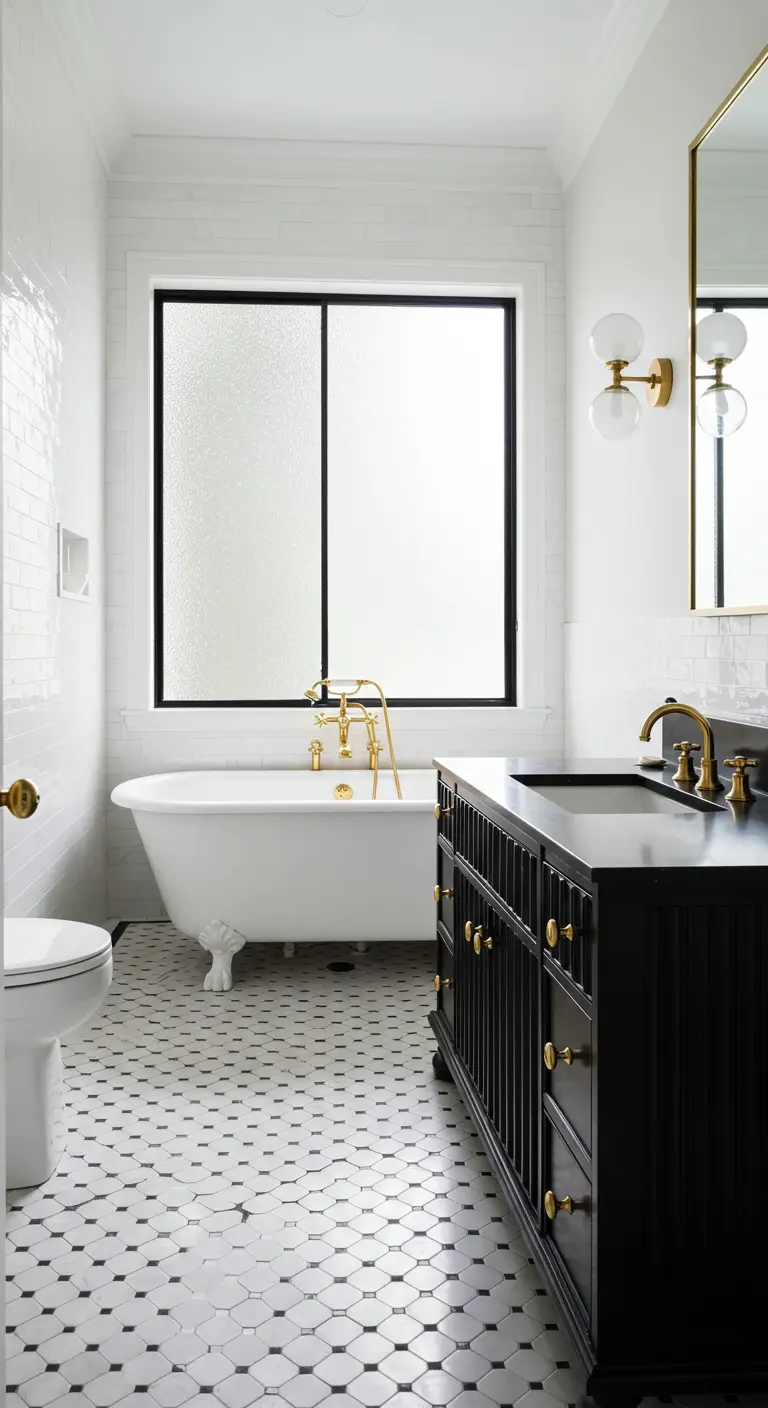
You can bring a sense of history into a modern design without it feeling dated.
The octagonal mosaic floor tile is a classic choice, but it feels fresh and intentional when paired with the stark contrast of a black-framed window and a sharp, black vanity.
The glossy white subway tile keeps the space bright and airy, showing how Deco elements can be integrated into a lighter palette.
This mix of old and new is similar to a coastal farmhouse mix, where different styles create a unique whole.
8. Create a Focal Point with Architectural Detail

In a large bathroom, symmetry and a single, dramatic focal point create a powerful sense of order and luxury.
The dual vanities and matching chandeliers guide your gaze directly to the freestanding tub, which is perfectly framed by a stunning arched alcove.
The black and gold sunburst tile within the arch is pure theater.
To replicate this on a smaller scale, you could paint an arch behind your tub or use a dramatic tile in the shower niche to create a similar effect found in opulent Baroque-inspired spaces.
9. Mix Terrazzo, Marble, and High-Gloss Lacquer

This bathroom is a masterclass in confidently mixing bold materials.
The playful pattern of the terrazzo floor, the classic luxury of the marble-clad tub, and the sleek drama of high-gloss black panels all coexist beautifully.
The secret is a disciplined color palette of black, white, and brass that acts as a common thread, unifying the diverse textures and patterns into a cohesive, sophisticated whole.
This thoughtful layering is key to creating successful eclectic interiors.
10. Use Backlighting for a Modern, Moody Glow
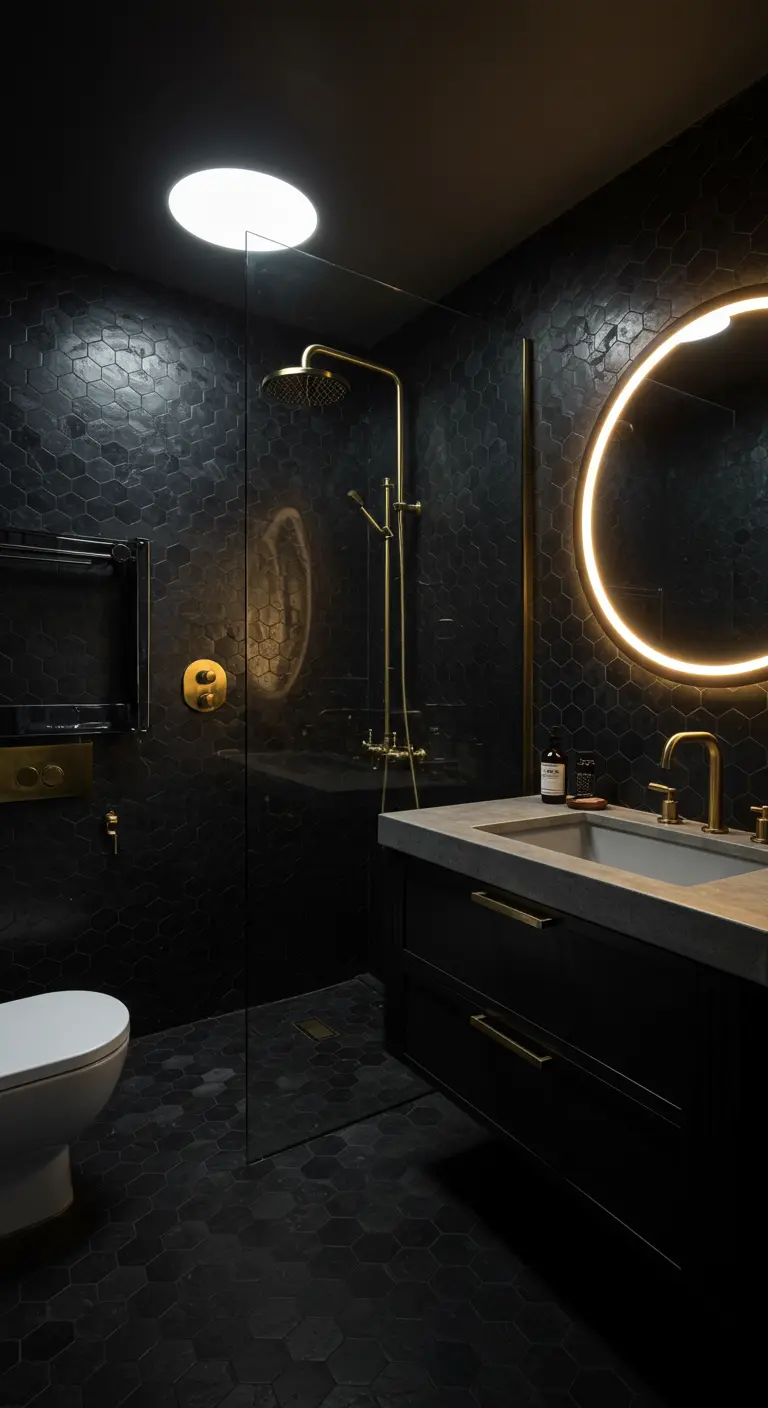
For an atmosphere that is both modern and moody, integrate backlighting into your design.
A backlit circular mirror provides soft, ambient light that eliminates the need for harsh overhead fixtures, creating a gentle halo effect that’s incredibly flattering.
When paired with dark, matte hexagonal tiles that absorb light, the mirror becomes the clear focal point.
This technique feels aligned with futuristic interiors that prioritize integrated lighting.
11. Soften Art Deco with Curves and Color

Art Deco design doesn’t have to be exclusively sharp and masculine; it can be softened with color and curved forms.
Here, dusty pink walls offer a warm, gentle counterpoint to the bold black and white floor.
The fluted vanity with its rounded corners and the graceful arch of the mirror add a layer of softness that feels both elegant and inviting, reminiscent of the charm in dreamy pastel patio dining pods.
12. Center the Room with a Statement Chandelier
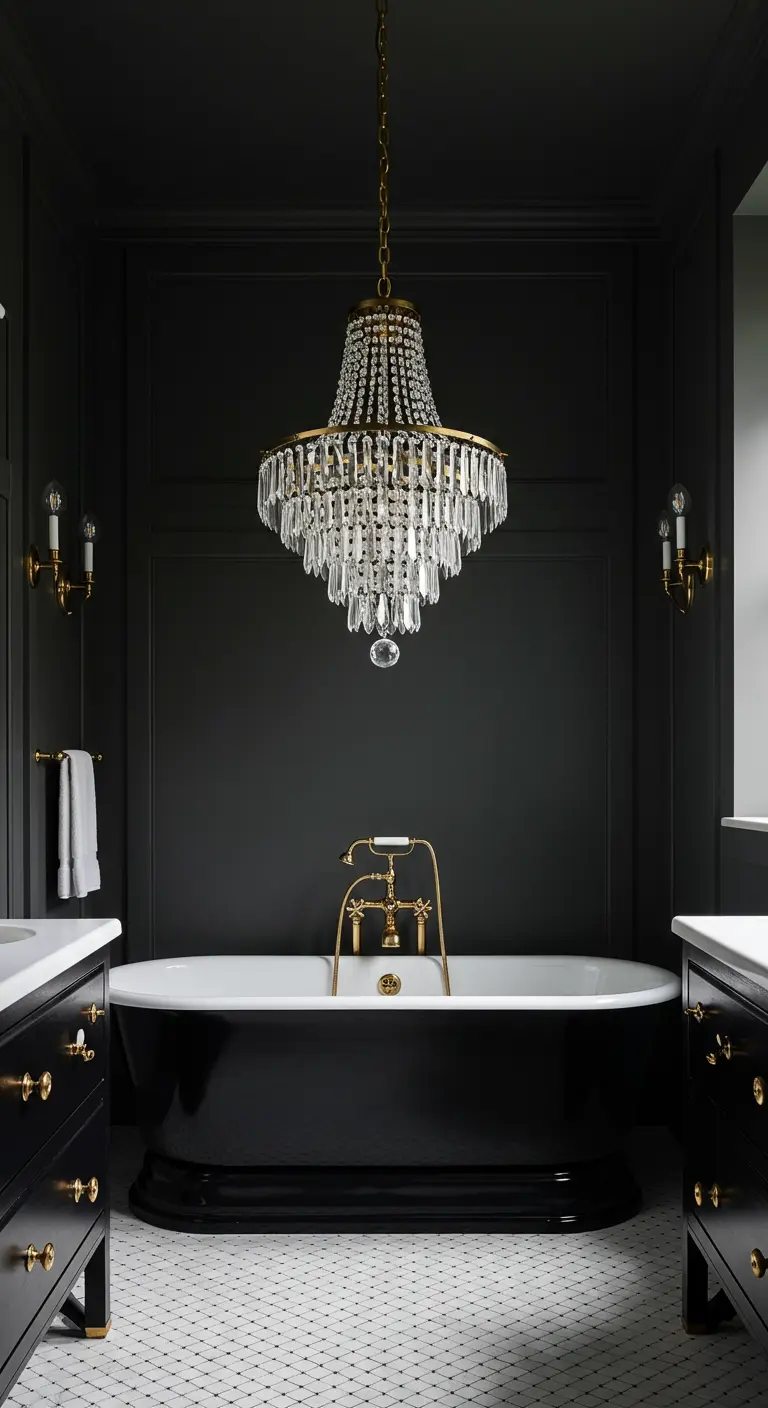
In a room with a dramatic, monochromatic palette, a single, spectacular light fixture can serve as the primary piece of art.
Positioning a grand crystal chandelier directly over the bathtub not only defines the bathing area as a zone of indulgence but also provides a dazzling counterbalance to the matte black walls.
The cascading crystals catch and refract light, adding sparkle and preventing the dark color from feeling flat, creating a celebratory mood perfect for luxe New Year’s Eve party decorations.
13. Frame Your Vanity with Metallic Trim
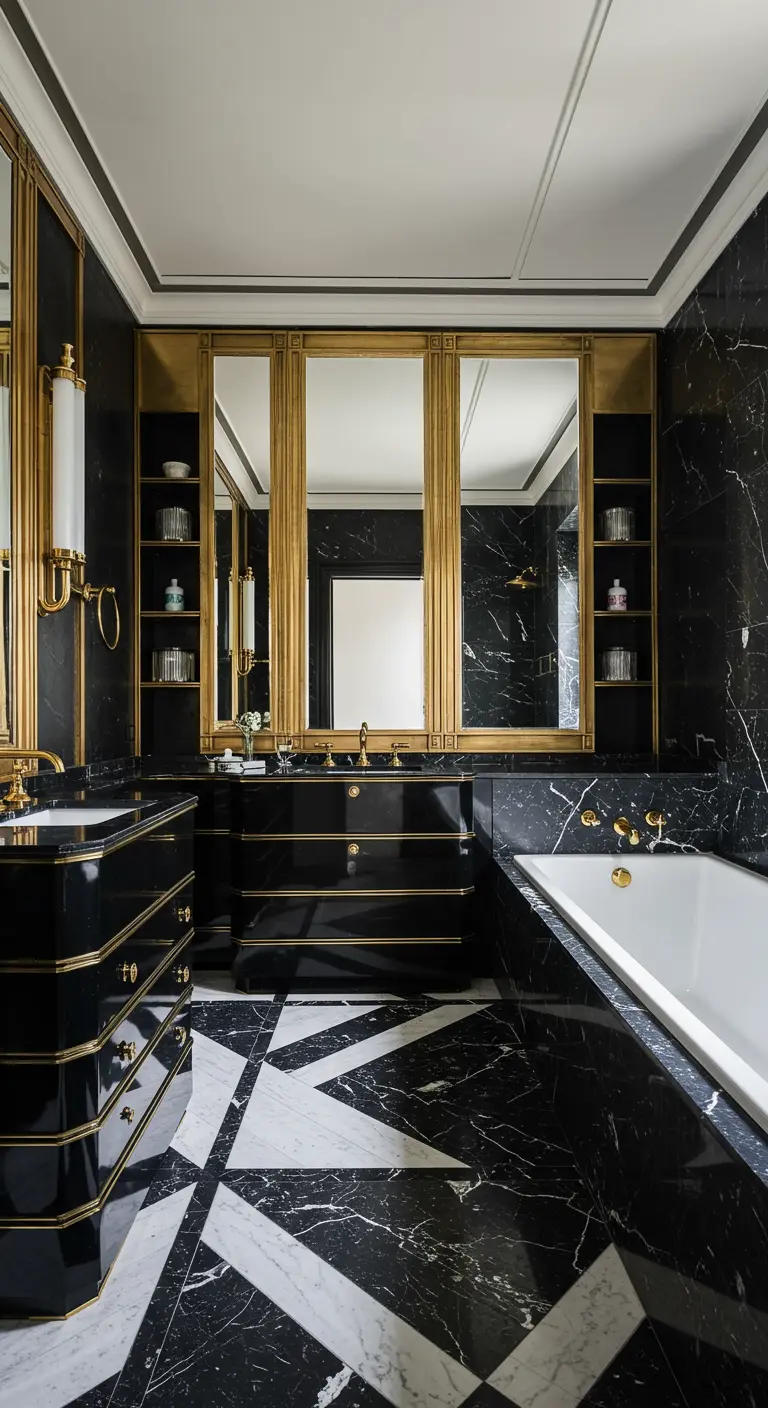
To give your bathroom a truly custom, high-end feel, create an architectural niche for the vanity area.
Framing the mirrors and cabinets with bold, metallic trim, as seen here, adds structure and a layer of polish that makes the entire wall feel intentional and integrated.
The open shelving within the gold framework breaks up the dark surfaces while offering curated display space, a hallmark of luxe Hollywood Regency living rooms.
14. Use Antiqued Mirror for Diffused Glamour
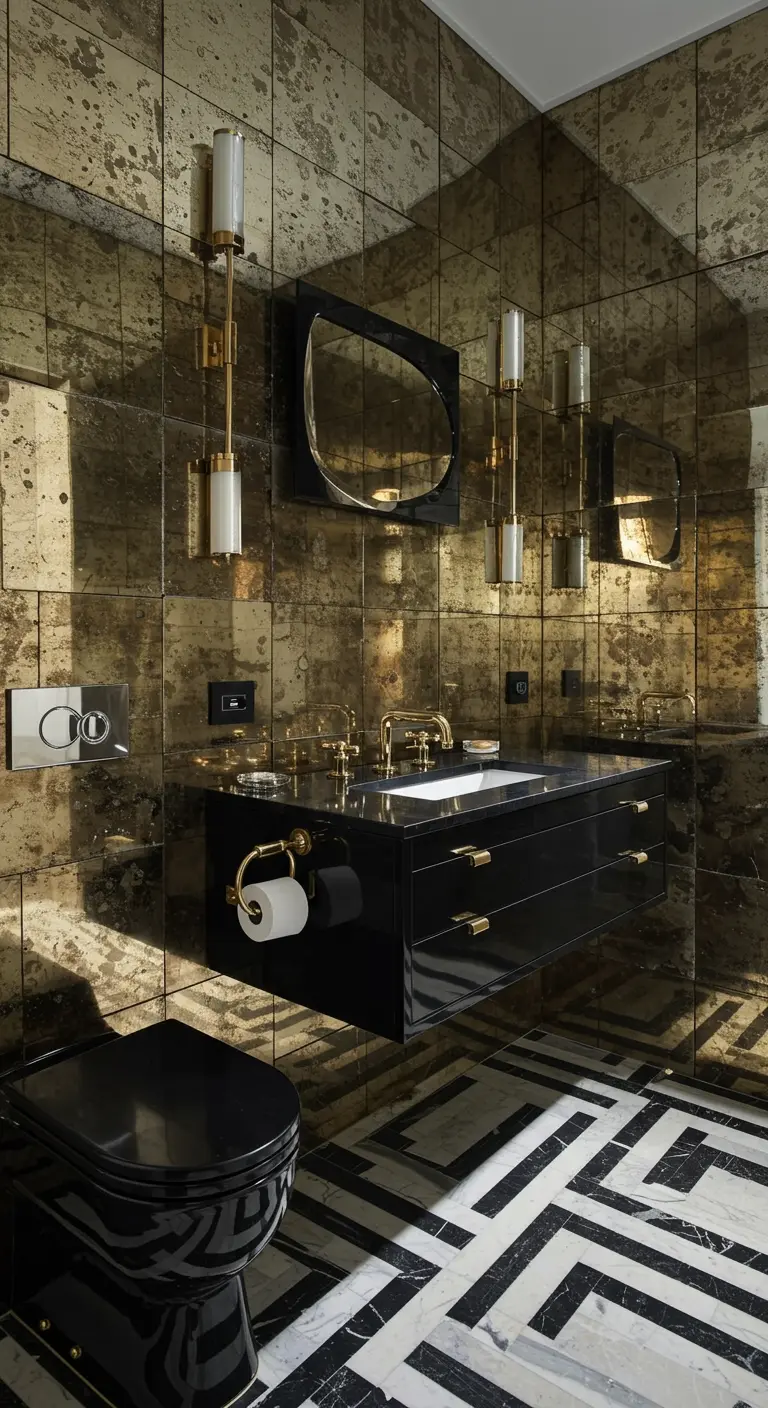
For glamour with a softer, more atmospheric touch, consider using antiqued mirror tiles as a wall treatment.
Unlike a standard mirror, the distressed finish diffuses reflections, adding depth and a sense of history without overwhelming brightness.
It provides a rich, textured patina that reflects light in a gentle, moody way—a perfect backdrop for a sleek, floating lacquer vanity.
This blend of old and new brings a worldly character, much like you’d find in Parisian apartment interiors.
15. Swap Black for Navy for a Softer Drama
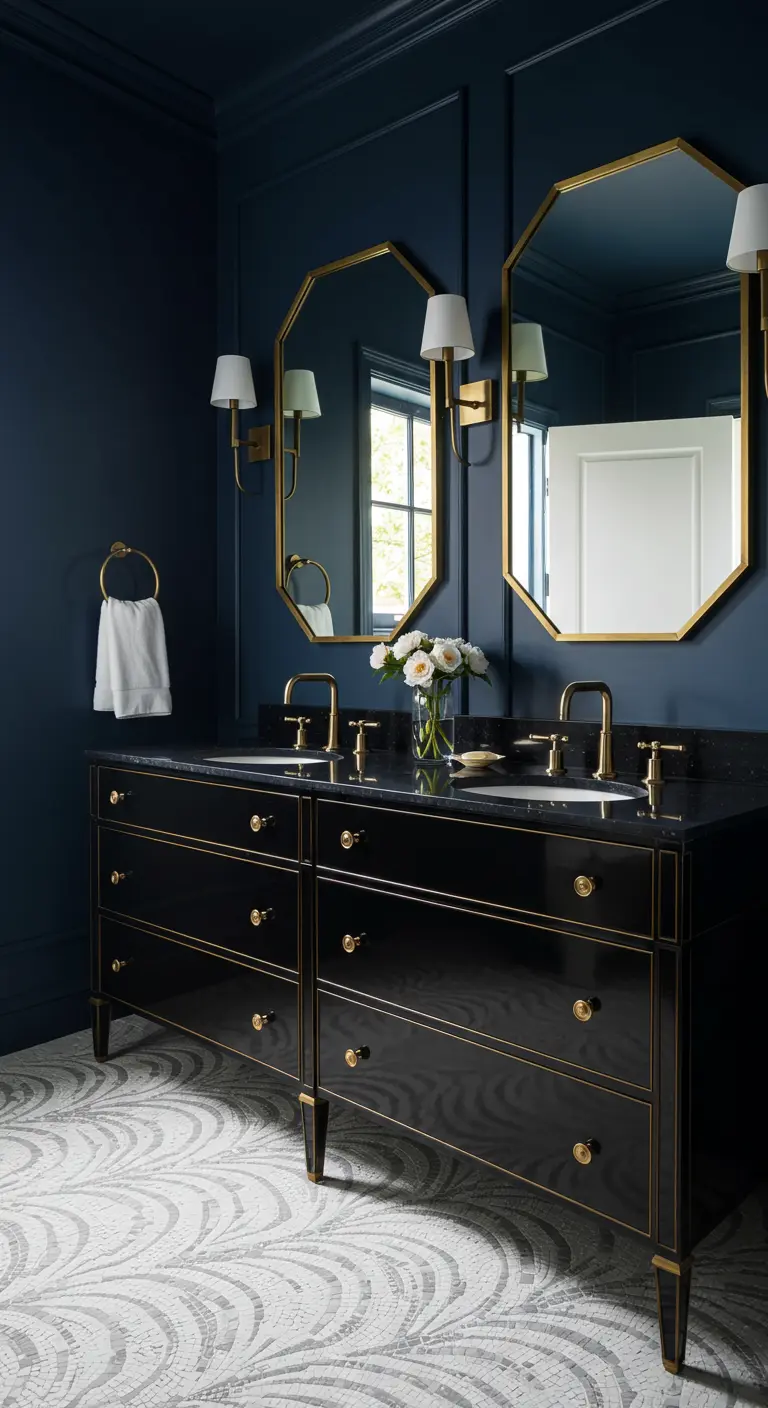
If you love the drama of a dark bathroom but find pure black too harsh, a deep, inky navy is an excellent alternative.
It provides a similar depth and sophistication but with a subtle softness that feels incredibly chic, especially when paired with the warmth of brass or gold hardware.
The octagonal mirrors offer a nod to Deco geometry that is distinctive yet understated, embodying the effortless elegance of Parisian-style interiors.
16. Go All-In on a Gold Accent Wall
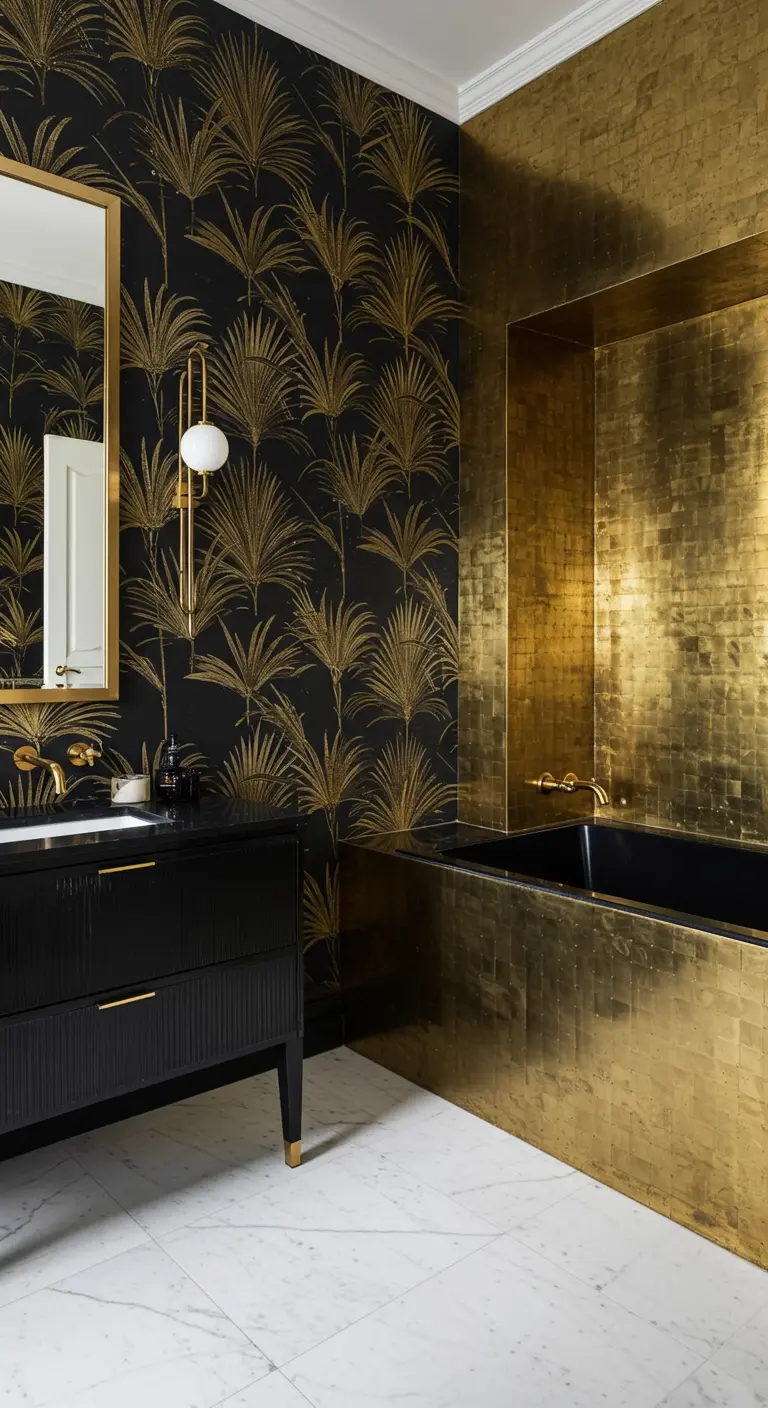
Create an unforgettable moment by transforming a functional area into a breathtaking feature.
Cladding the entire tub and shower alcove in shimmering, gold-leaf effect tiles turns it into a radiant jewel box that glows with warmth.
To ensure this feature remains the star, balance it with a dark botanical wallpaper and a simple white marble floor, a strategy that also works in boho tropical bathrooms.
17. Reimagine Terrazzo for a Modern Deco Feel
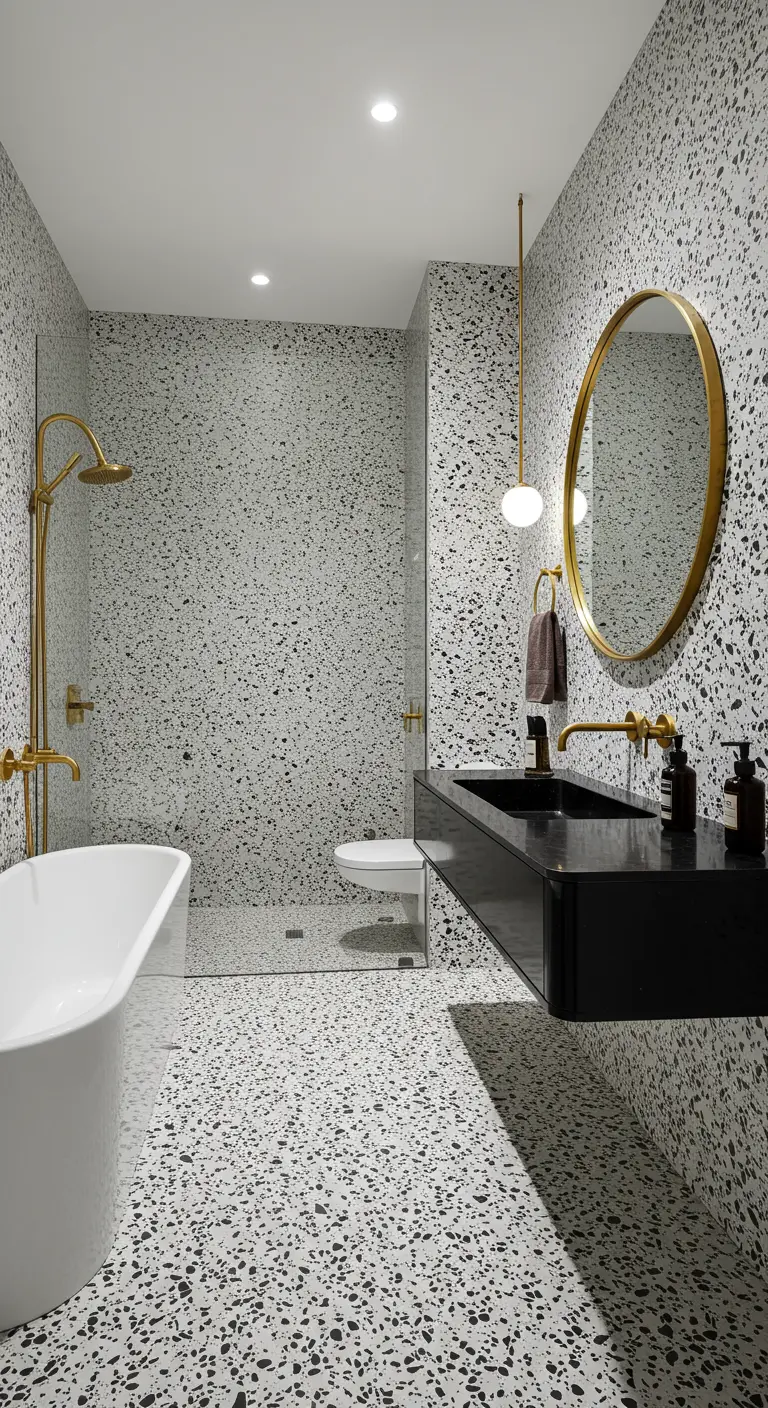
Terrazzo, a composite material popular during the original Art Deco period, is experiencing a modern revival.
Using it seamlessly across both floors and walls creates a unified, textural envelope for the room.
Keep the other elements minimal—a sleek floating sink, a single globe pendant—to allow the graphic, playful quality of the terrazzo to take center stage.
This approach gives a fresh, contemporary spin to monochrome bathroom schemes.
18. Guide the Eye with a Floor Tile “Runner”

In a long, narrow bathroom, you can use flooring to solve a layout challenge and add major design impact.
Creating a tile “runner” with a contrasting geometric pattern down the center of the floor draws the eye forward, making the space feel more expansive and directional.
It’s one of the most creative ways to define spaces without adding physical barriers.
The glittering gold accent tile at the end of the path in the shower provides a rewarding visual destination.
19. Draw Attention Upward with a Statement Ceiling
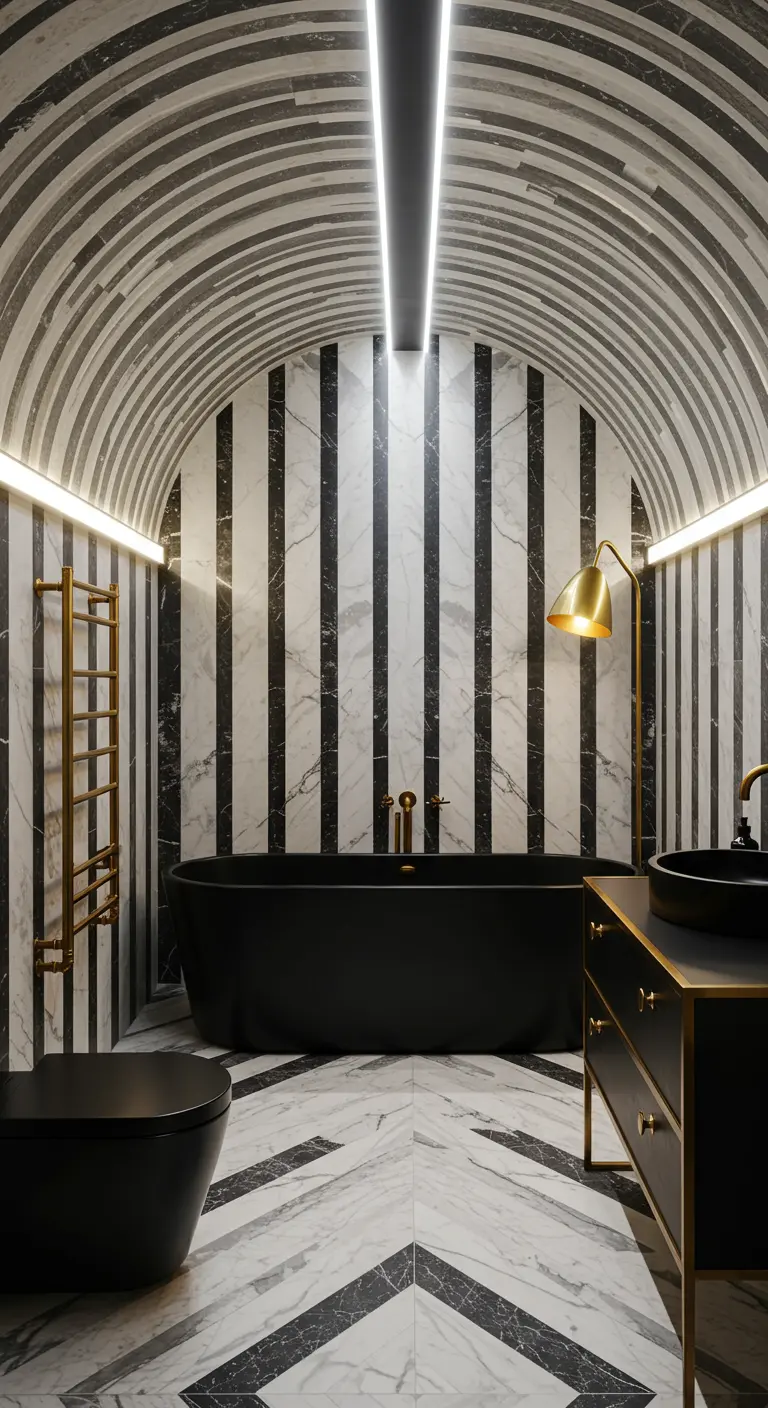
Never underestimate the design potential of the ceiling, often called the “fifth wall.”
A dramatic barrel-vaulted ceiling, clad in striking black and white marble stripes, completely transforms this bathroom from a simple room into an architectural masterpiece.
The choice to run stripes vertically on the back wall creates a cohesive and powerful graphic statement, resulting in a distinctly black & white interior with unforgettable impact.
For a less permanent version, try high-quality, removable wallpaper on your ceiling.
20. Incorporate Nature-Inspired Deco Motifs
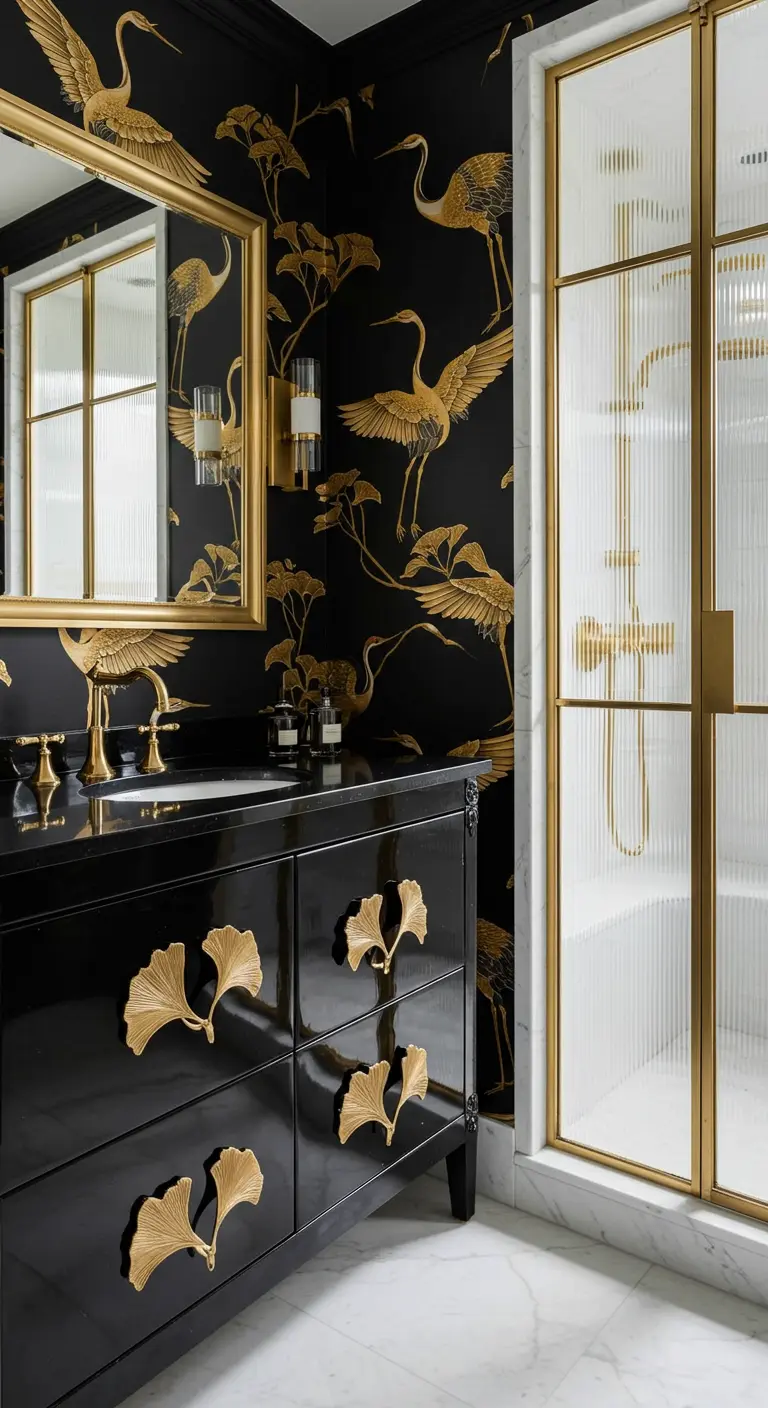
The Art Deco movement often celebrated stylized natural forms, offering a beautiful way to bring organic elegance into your design.
Pairing elegant Chinoiserie wallpaper featuring cranes with custom ginkgo leaf drawer pulls creates a sophisticated, nature-inspired narrative.
The reeded glass of the shower door subtly echoes the vertical lines of the wallpaper’s botanicals while providing texture and privacy, a perfect feature for Chinoiserie-inspired bathrooms.
21. Layer Geometries with Tone-on-Tone Texture
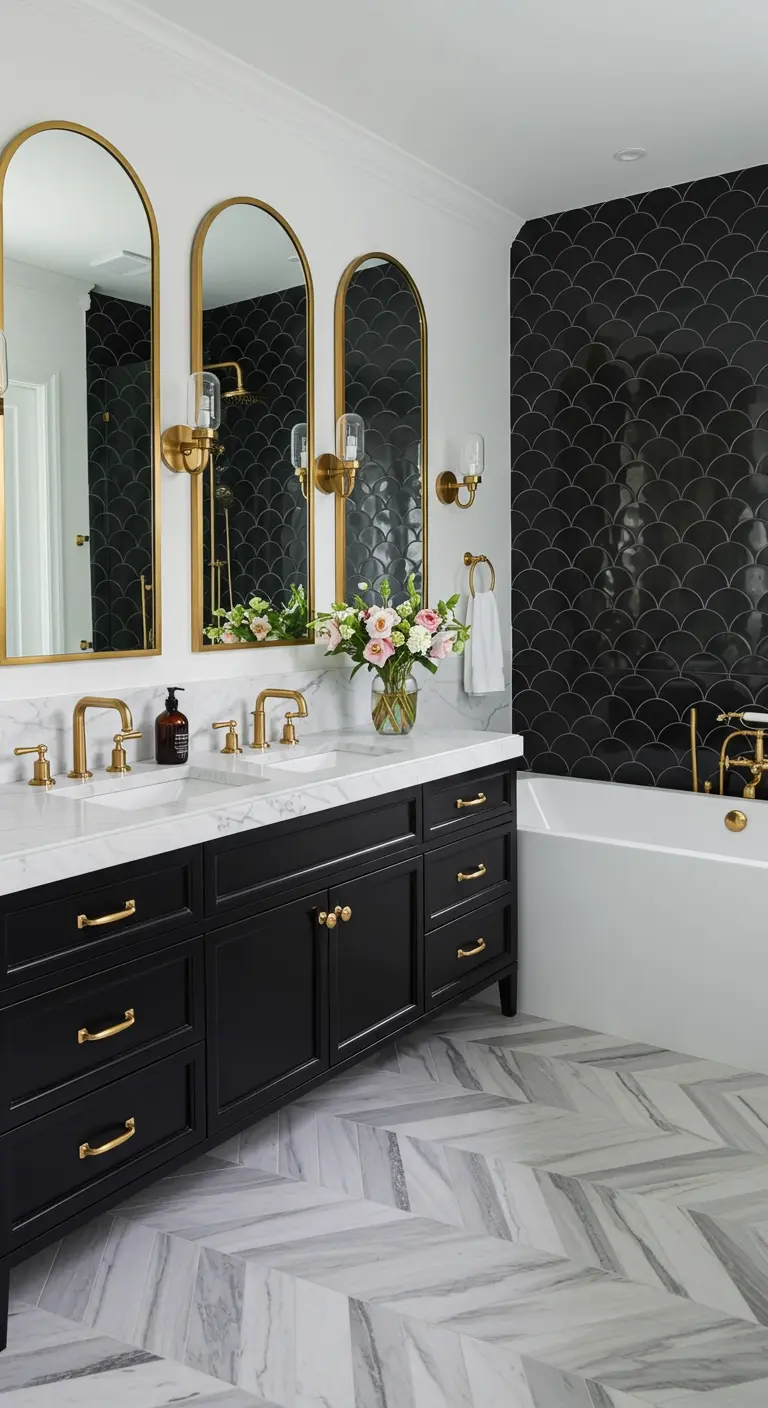
You can successfully layer multiple geometric patterns without creating visual chaos by focusing on texture over color.
This design masterfully combines arched mirrors, a herringbone floor, and a fan-shaped tile wall.
It works because the wall is a tone-on-tone pattern—glossy black scallops on a matte black field—that reads as a subtle, light-catching texture from a distance.
This sophisticated use of pattern is one of many graphic tile bathroom ideas that feels elevated.
22. Try Plaster Walls for a Softer Foundation

For a more understated and minimalist interpretation of Art Deco, consider swapping bold patterns for the soft texture of plaster walls.
The subtle, hand-troweled variations in a lime wash or tadelakt finish create a warm, organic backdrop with incredible depth.
This allows the clean lines of the floating vanity and the warm gleam of the brass fixtures to become the quiet focal points.
The effect is earthy and serene, echoing the principles of serene Japandi interiors.
23. Add Opulence with Moody Florals and Velvet
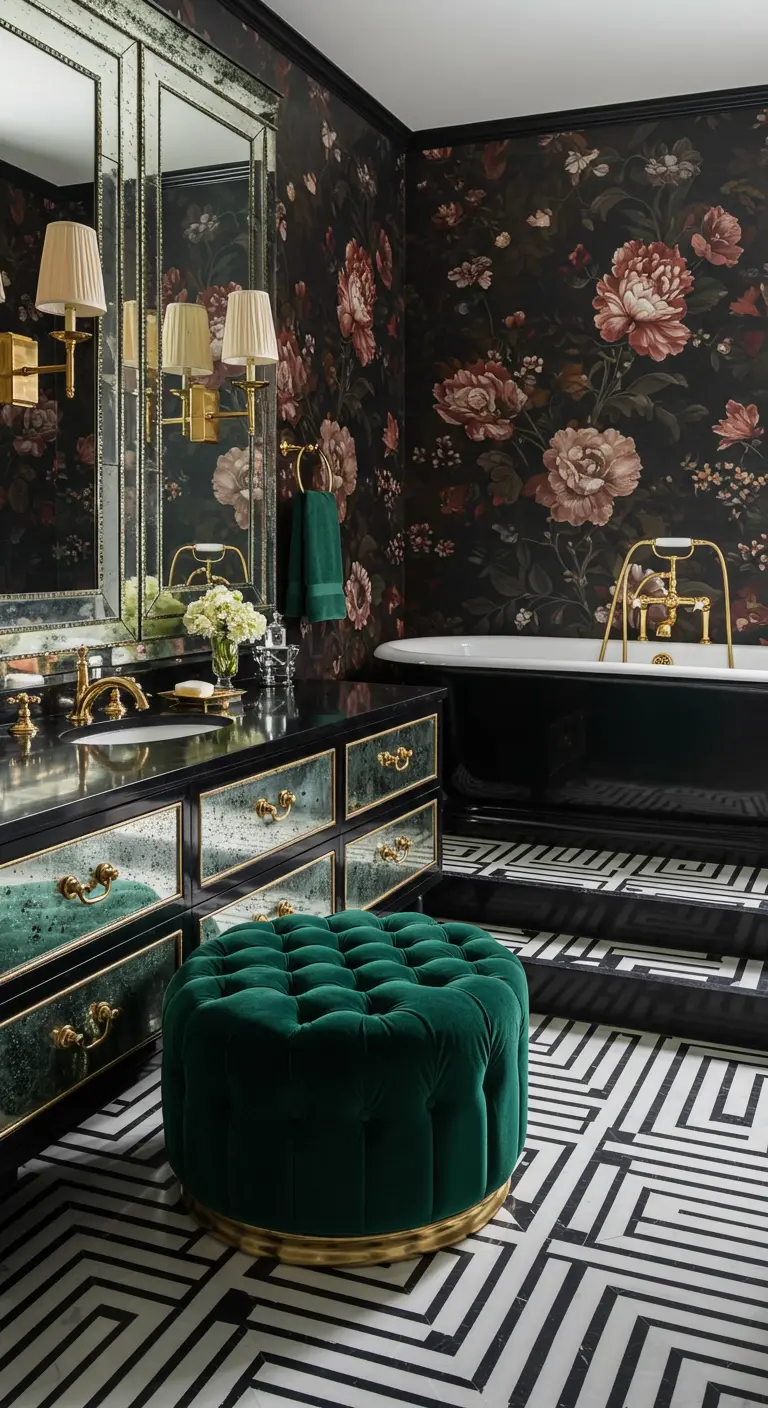
Introduce a layer of romanticism to your Art Deco bathroom with a dramatic, large-scale floral wallpaper.
The dark, moody background allows the jewel-toned flowers to command attention, a style also found in romantic Victorian bathrooms.
An emerald green velvet ottoman adds a touch of plushness and invites you to linger, while a vanity with mirrored drawer fronts reflects the pattern and light, enhancing the room’s decadent feel.
24. Play with Light and Shadow Using 3D Tiles

Create a wall that is a constantly changing work of art by using dimensional tiles.
The raised geometric pattern of these 3D tiles interacts with light, creating a dynamic play of highlights and shadows that evolves throughout the day.
When illuminated by a skylight or a well-placed sconce, the effect is amplified, adding texture and depth to a neutral wall without needing color.
This is one of the smartest stylish lighting tricks to make a space feel special.
25. Introduce Rich Wood Tones for Warmth
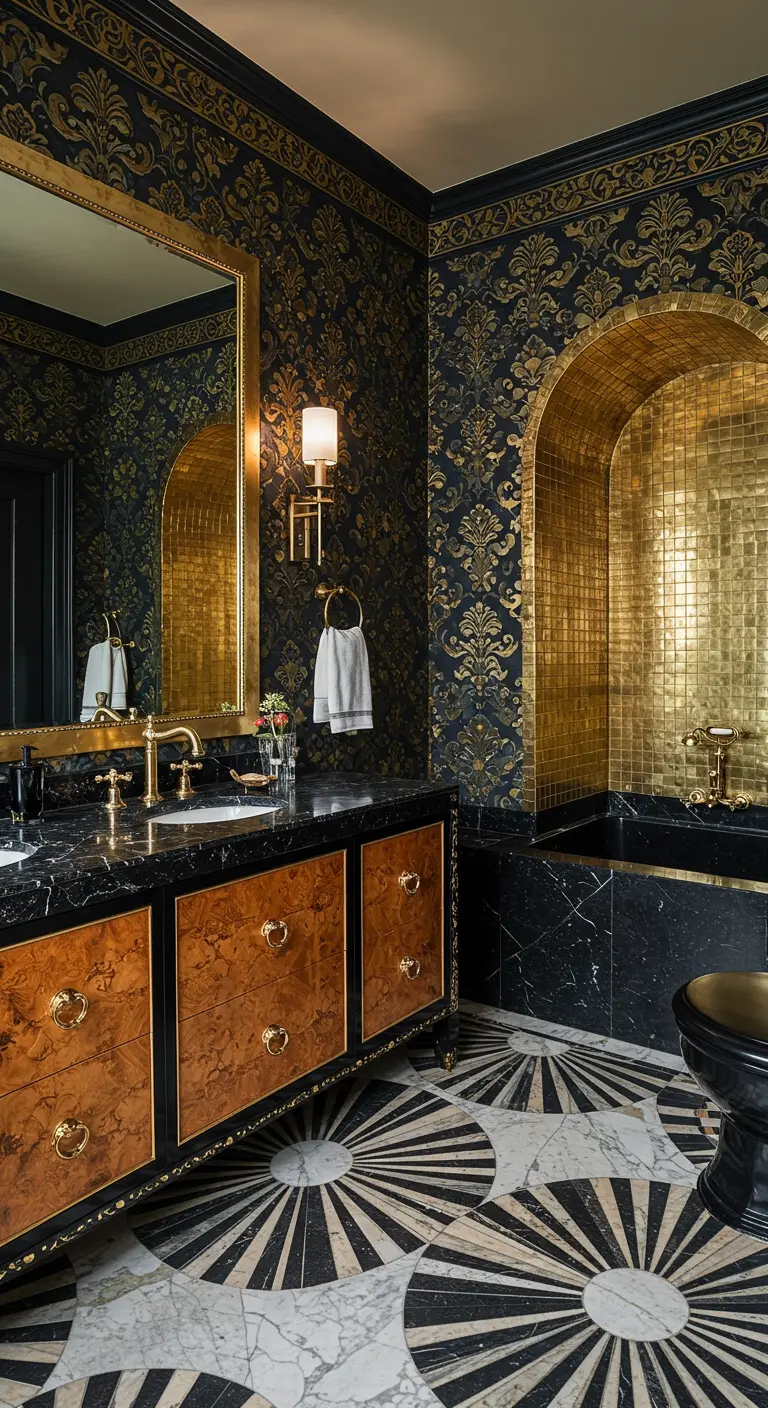
Balance the cool glamour of a black and gold palette by incorporating the organic warmth of rich wood.
A vanity with burl wood drawer fronts introduces a swirling, natural pattern that provides a beautiful textural contrast to the formal damask wallpaper and shimmering mosaic tile.
This mix of materials—lacquer, wood, metal, and marble—feels layered, personal, and collected over time, much like the curated feel of warm rustic living rooms.
